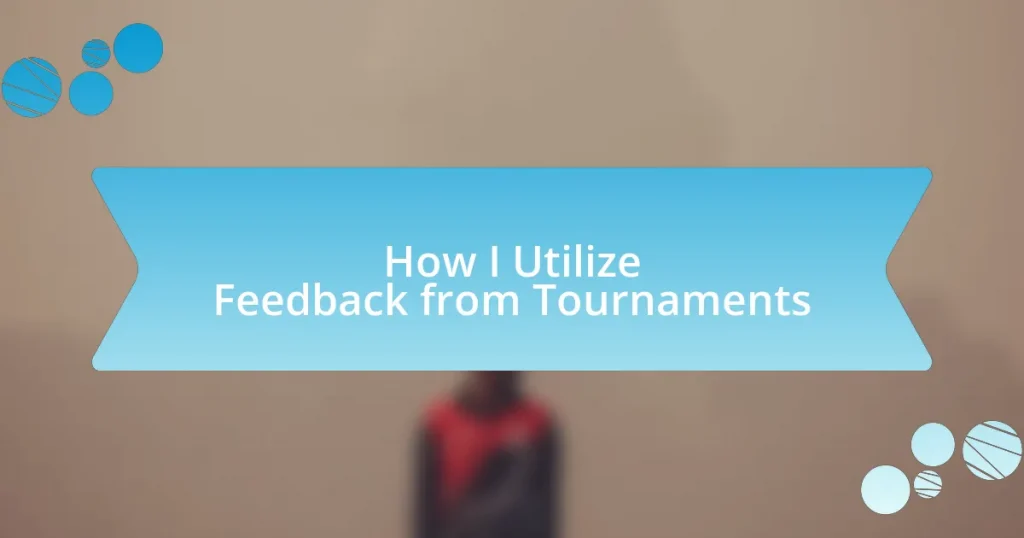Key takeaways:
- Tournament feedback is essential for skill improvement, revealing strengths and highlighting areas for growth.
- Different types of feedback (verbal, peer evaluation, self-assessment) provide unique insights that enhance performance analysis.
- Setting specific improvement goals, based on performance data, helps maintain focus and track progress effectively.
- Engaging in open communication with coaching staff and incorporating feedback into training sessions fosters collaborative growth and emotional resilience.
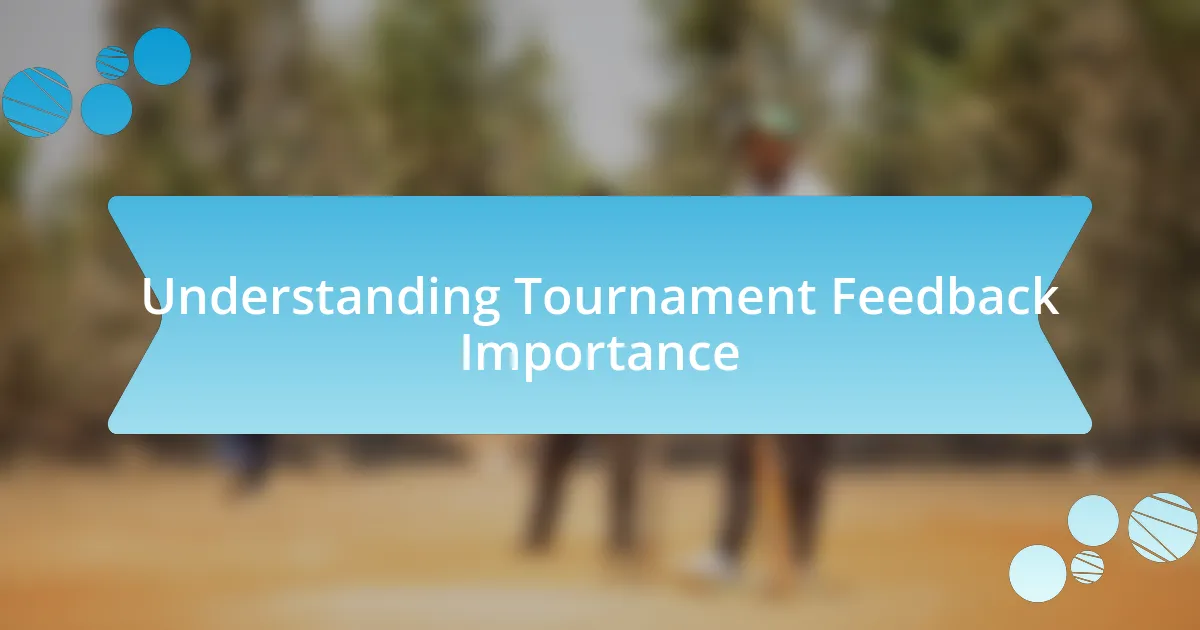
Understanding Tournament Feedback Importance
Feedback from tournaments is crucial because it serves as a mirror, reflecting our strengths and areas for improvement. I remember one particular tournament where I received a detailed critique from a judge. It highlighted a few mistakes I thought were minor, but realizing their impact really changed my perspective on how I approach my game.
Think about it: how often do we receive feedback outside of competitive settings? It’s rare to get such targeted insights that can propel our skills forward. I vividly recall after a match, discussing my performance with peers. Their input not only boosted my confidence but also opened my eyes to tactics I hadn’t considered before.
Moreover, tournament feedback often reveals patterns in our performance that we might overlook. I’ve found that consistently reviewing this feedback has allowed me to track my progress over time. Isn’t it interesting how that process of reflection can transform what seems like a failure into a stepping stone towards success? Embracing this feedback is like finding a treasure trove of growth opportunities.

Types of Feedback from Tournaments
Feedback from tournaments can come in various forms, each offering distinctive insights. One type is verbal feedback from judges, which often provides immediate, constructive criticism. I remember the first time a judge pointed out the importance of my stance during a match; despite my focus on strategy, my posture was hindering my performance. This feedback was pivotal, reshaping my approach not only for that tournament but for future competitions as well.
Another significant source of feedback is peer evaluation. I cherish the moments spent debriefing with teammates after a tournament. Their shared observations often highlight things I’ve missed, like specific game strategies or psychological aspects of my play. For instance, a fellow competitor once noted that I seemed hesitant at critical moments. Their candidness helped me recognize my tendency to second-guess myself and inspired me to work on my mental resilience.
Lastly, self-assessment following a tournament is vital. Sitting down with my performance records has led to powerful realizations. After reviewing game footage from a particularly tough match, I felt a mix of frustration and enlightenment. Seeing my decisions on screen allowed me to objectively analyze my choices. This type of introspection spurs growth, as I can pinpoint exactly what tactics worked and what didn’t, shaping more informed strategies for future tournaments.
| Type of Feedback | Description |
|---|---|
| Verbal Feedback | Immediate, constructive criticism from judges or referees. |
| Peer Evaluation | Insights and comments from teammates or fellow competitors. |
| Self-Assessment | Personal reflection based on performance records and data. |
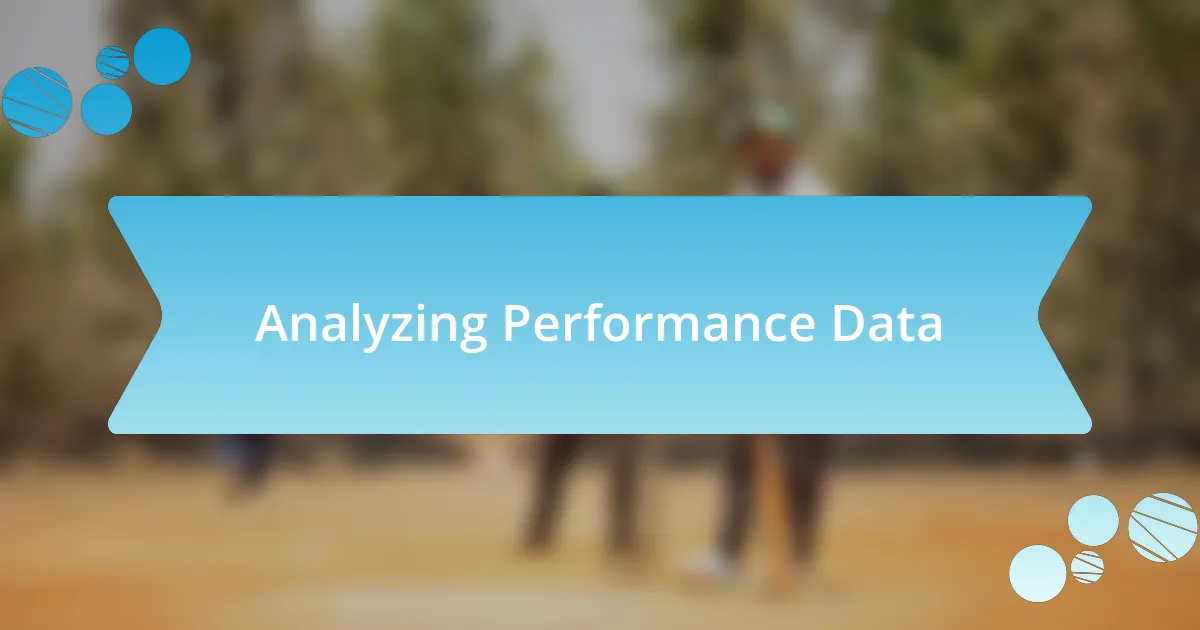
Analyzing Performance Data
When I dive into analyzing performance data, it feels like unlocking secrets about my gameplay. Reviewing metrics from previous tournaments shows patterns that aren’t always evident in the heat of competition. For instance, I once discovered that my execution timing was consistently off during critical points, which shocked me. This realization not only highlighted key areas for improvement but motivated me to incorporate specific drills into my practice routine to enhance my timing.
Consider these essential elements when analyzing performance data:
- Win-Loss Ratios: Assessing the outcomes of matches provides a clear picture of overall performance.
- Execution Percentages: Tracking successful moves versus attempted moves helps pinpoint areas for improvement.
- Reaction Times: Evaluating how quickly I respond to in-game situations can uncover crucial gaps in my play.
- Game Footage: Watching recordings reveals insights about decision-making that statistics alone may not convey.
Reflecting on this process often stirs a mix of anticipation and trepidation within me. I’ve learned that knowing the numbers is only part of the story; it’s the emotions tied to those statistics that truly fuel my passion for growth and excellence.
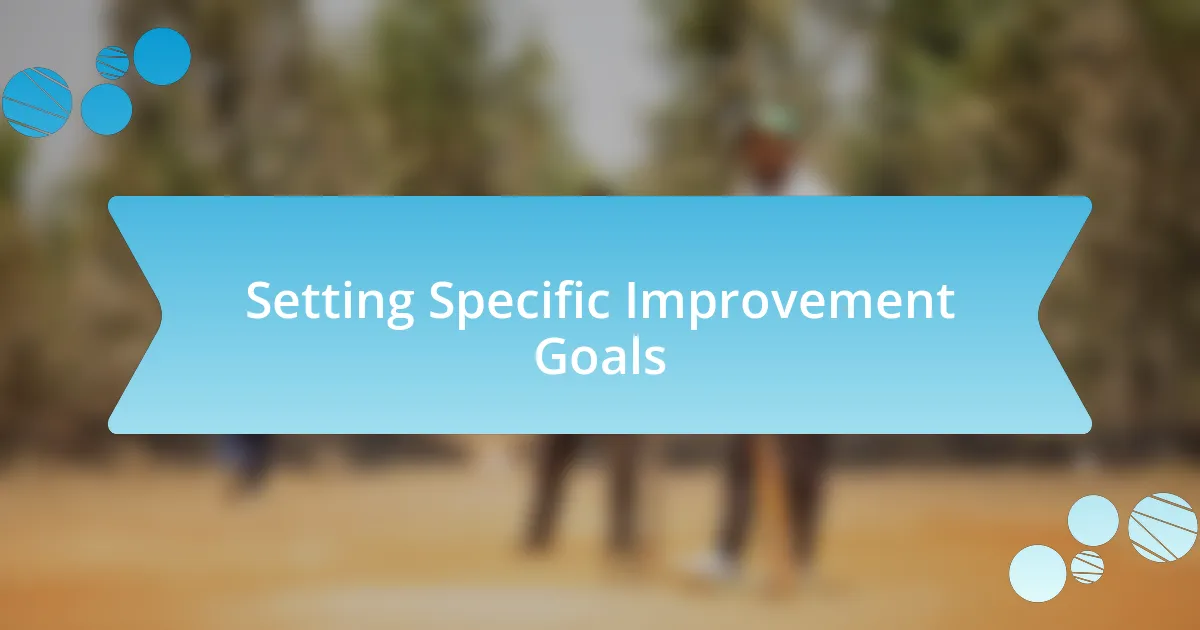
Setting Specific Improvement Goals
After analyzing my performance data, I realized that setting specific improvement goals becomes essential. For example, instead of vaguely saying, “I want to get better at my game,” I decided to focus on one aspect: my decision-making under pressure. I remember a tournament where I panicked during a crucial moment and made a poor call. That moment stuck with me, prompting me to define a clear goal: “I will practice making quick decisions in high-stakes scenarios using simulation exercises.” This clarity transformed my practice, guiding my focus and helping me track progress more effectively.
To ensure these goals are practical, I often break them into actionable steps. When I aimed to enhance my reaction time, I incorporated drills that challenged me to respond to unexpected situations rapidly. I vividly recall working on these drills during a weekend training session, feeling my heart race as I targeted faster responses. After a few weeks, I checked in on my progress and was thrilled to see dramatic improvements, boosting my confidence for the next tournament.
It’s crucial to keep revisiting and refining these goals as I grow. For instance, after a particularly challenging match where I struggled to execute certain moves, I recognized the need to adjust my improvement targets accordingly. Asking myself questions like, “What specifically hindered my performance?” helps me pinpoint new areas to tackle. Ultimately, this iterative process of setting and adjusting goals not only keeps me engaged but also fuels my relentless pursuit of excellence.
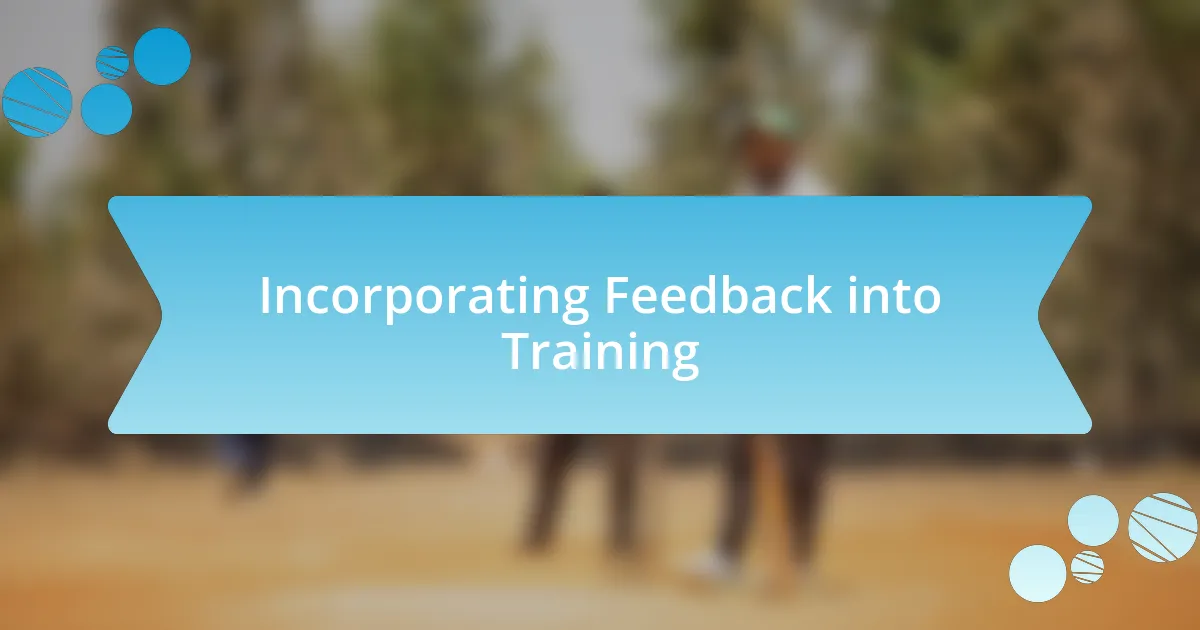
Incorporating Feedback into Training
Once I’ve identified my improvement goals, the next step is figuring out how to incorporate feedback effectively into my training regimen. For instance, after a tournament, I often review my matches with a coach or mentor. One particular instance stands out: I was advised to analyze not just my mistakes but also my successful plays. This approach transformed my training sessions, allowing me to replicate effective strategies while eliminating bad habits.
I find that practical exercises, tailored to the feedback I’ve received, accelerate my learning. In one memorable training session, I practiced a series of drills designed around the feedback I gathered about my footwork. As I moved through them, I felt a mix of frustration and exhilaration—frustration from the initial awkwardness of adjusting my technique, but exhilaration as I gradually noticed my improved agility. Isn’t it fascinating how uncomfortable it can feel to evolve, yet those moments often lead to the most significant breakthroughs?
Reflection is also a key part of effectively integrating feedback into training. After every practice session, I take a moment to jot down what worked well and what didn’t. I remember a particularly tough week where my performances seemed to plateau. Reflecting on that time helped me realize I wasn’t implementing the feedback I had so eagerly received. By shifting my mindset and embracing that feedback, I reignited my passion and returned to my training with renewed focus. Each piece of feedback isn’t just criticism; it’s a stepping stone toward growth.
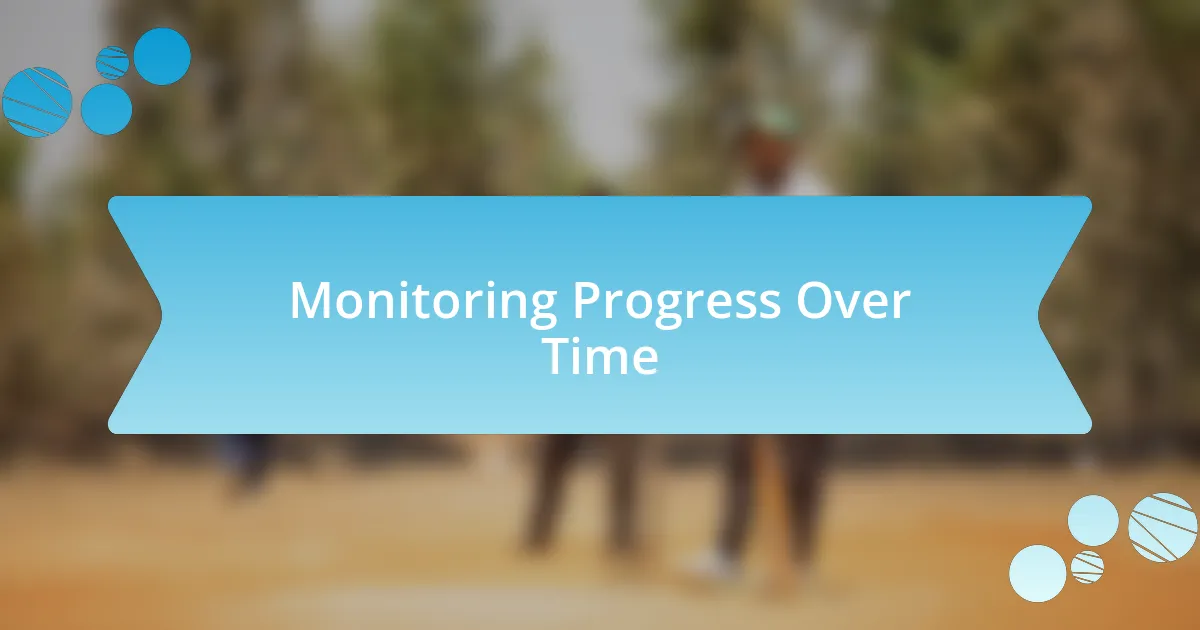
Monitoring Progress Over Time
Monitoring my progress over time is essential to understanding how effectively I’m implementing feedback. After each tournament, I like to create a visual representation of my performance metrics, such as win-loss ratios and skill proficiency levels. It’s fascinating to track these numbers; I often find that certain areas show consistent growth, while others may fluctuate, prompting me to dig deeper into what might be causing those variations.
I remember one tournament where my performance in stride control was noticeably weak compared to prior events. I pulled up my stats, and there it was—an undeniable dip. That realization hit hard. It made me reflect on my training habits; perhaps I had neglected specific drills that focused on foot placement, as I had been so eager to strengthen my strategic plays. It’s a humbling experience to see the numbers and realize they are often a mirror to my commitment and adaptability.
In the long run, I find that keeping a journal of my experiences also plays a vital role in monitoring my progress. I relish reading back through my entries; they capture my thoughts, frustrations, and victories in real time. Each entry encapsulates a moment of growth, solidifying the lesson learned while encouraging me to persist. Don’t you think it’s incredible how reflecting on past experiences can enhance our understanding of the present?

Sharing Insights with Coaching Staff
When it comes to sharing insights with my coaching staff, I always prioritize open communication. I find that discussing my performance with them brings fresh perspectives that can often be overlooked in my self-reflection. For instance, after one particularly challenging tournament, I sat down with my coach, and we analyzed my gameplay frame by frame. That conversation deepened my understanding of the strategic mistakes I had made, turning my frustration into focused improvement.
I also like to bring tangible data to those discussions. By using the performance metrics I’ve compiled, I can paint a clearer picture of my journey. One time, I vividly recall presenting my stats related to decision-making under pressure; my coach’s face lit up as we identified specific moments where I needed to trust myself more. This back-and-forth exchange not only validated my observations but also fostered a collaborative atmosphere where learning became a shared experience.
This sharing process isn’t just about numbers; it’s also about emotions and mindset. I remember expressing my feelings of self-doubt after a loss and how that affected my gameplay. My coach responded with a reminder of past successes and strategies to manage those emotions. It’s moments like these where I realize that insights and emotions are deeply intertwined. Have you ever had a conversation that transformed your perspective? Those connections with my coaching staff continually motivate me to grow, reminding me that I’m not alone on this journey.










